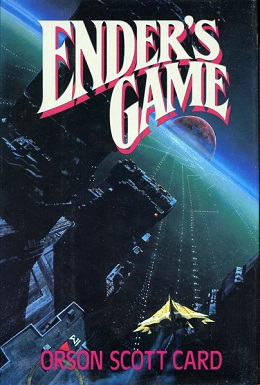 “I’ve watched through his eyes, I’ve listened through his ears, and I tell you he’s the one. Or at least as close as we’re goign to get.
“I’ve watched through his eyes, I’ve listened through his ears, and I tell you he’s the one. Or at least as close as we’re goign to get.
“That’s what you said about the brother.”
“The brother tested out impossible. For other reasons. Nothing to do with his ability.”
“Same with the sister. And there are doubts about him. He’s too malleable. Too willing to submerge himself in someone else’s will.”
“Not if the other person is his enemy.”
“So what do we do? Surround him with enemies all the time?”
“If we have to.”
“I thought you said you liked this kid.”
“If the buggers get him, they’ll make me look like his favorite uncle.”
“All right. We’re saving the world, after all. Take him.”
Thus begins one of the greatest SF classics of all time, Ender’s Game. With such a spectacular beginning, it only keeps getting better.
I decided to reread Ender’s Game because a friend of mine in Washington was reading it. I read this book back in high school in only two sittings–the first twenty pages in the library, and the rest back home, where I finished it wide-eyed at three in the morning. I didn’t regret a single moment of it, then or now.
One of the most fascinating things to me about this book is the way that Orson Scott Card breaks almost all of the rules of writing. On every page, he “tells” much more than he “shows”–some of the battles he glosses over in only a couple of paragraphs. He gives only minimal setting details, and very few of these are visceral or concrete–it’s very hard to “get into” the world of Ender’s Game the way you would with a fantasy novel. Most of the characterization consists of “navel gazing”–Ender thinking to himself about how bad things are, rather than taking action.
Breaking these rules, however, is exactly the thing that makes this a good book. The story isn’t in the setting, or in the nitty gritty of the battles–it’s in Ender’s mind, how he reacts to the forces around him, and how those forces change him. “Telling” rather than “showing” allows him to keep the pace at a breakneck, thrilling speed while cutting out unnecessary details, and the “navel gazing” allows us to get an intimate picture of Ender’s mind.
It goes to show that good writing isn’t just about knowing the rules, but knowing how to break them. And when it comes to plot, character, pacing, foreshadowing, thematic elements, and the hero cycle, Orson Scott Card proves his masterful brilliance in this work beyond a doubt.
One of the most fascinating things about this book is that it hits all eight points of the Campbellian monomyth. This excellent article (originally published in Leading Edge) explains how. The most incredible thing to me is that the year after Ender’s Game came out, Orson Scott Card did it all again–wrote a blockbuster book hitting all eight points of the monomyth–with Speaker for the Dead, which I think is a superior book.
Ender’s Game is a true classic of the science fiction genre. Not only is it a highly entertaining story, it is deeply meaningful and insightful as well. It’s one of those books you can reread multiple times, and it only keeps getting better. Whether or not you’re a fan of science fiction, this is a book you will deeply benefit from reading.